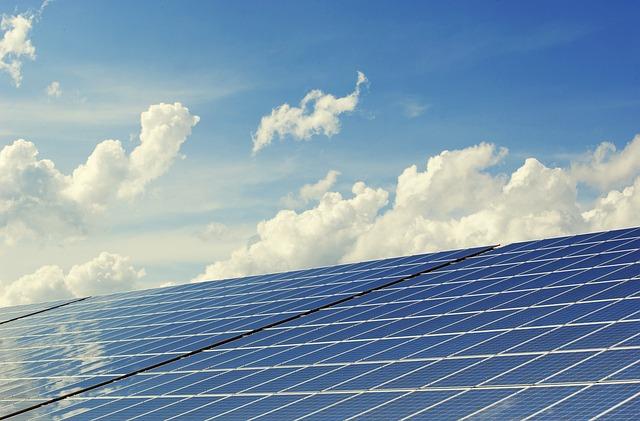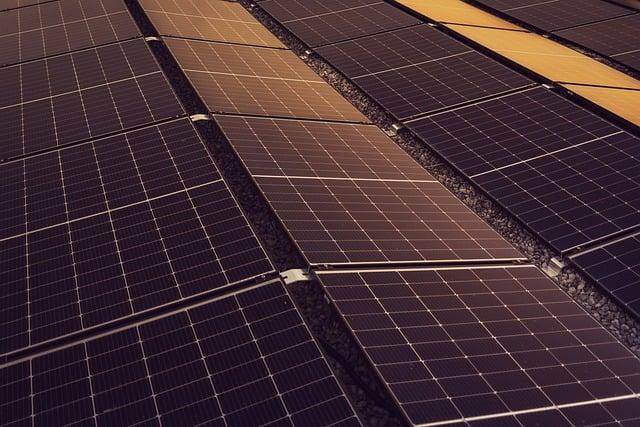In a world where the sun’s abundant energy promises a future free from fossil fuels, an unlikely ally emerges to unlock its full potential: blockchain technology. Picture a neighborhood where solar panels glisten atop every rooftop, each one not just a source of clean energy but also a node in a vast, decentralized network. Here, electricity flows seamlessly from home to home, and every ray of sunshine can be tracked, traded, and transformed into a digital asset. This is the new frontier of solar energy trading, where blockchain’s immutable ledger meets the limitless power of the sun, crafting a marketplace as dynamic and transparent as the technology driving it. As we delve into this innovative fusion, we explore how blockchain is revolutionizing the way communities harness, share, and benefit from solar power, ushering in an era of energy democratization and sustainability.
Blockchain Empowering the Solar Revolution
In the quest for cleaner and more sustainable energy solutions, blockchain emerges as a transformative force in solar energy trading. By leveraging decentralized ledgers, blockchain facilitates transparent and secure transactions, enabling individuals and communities to trade solar energy seamlessly. This innovative approach not only democratizes energy distribution but also enhances efficiency, reducing reliance on centralized power grids.
- Decentralization: Empowers local producers and consumers to engage directly without intermediaries.
- Security: Ensures data integrity and transaction authenticity through cryptographic protocols.
- Transparency: Provides an immutable record of all transactions, fostering trust among participants.
- Efficiency: Streamlines processes, reducing overhead and transaction costs.

Decentralized Trading Platforms: The Future of Solar Energy
As the global energy landscape shifts towards sustainability, innovative technologies are transforming how we produce, distribute, and trade solar energy. Blockchain technology stands at the forefront of this revolution, offering a decentralized approach that enhances transparency, security, and efficiency in energy trading. By leveraging blockchain, solar energy can be traded in a peer-to-peer manner, eliminating intermediaries and reducing costs. This paradigm shift not only democratizes energy access but also empowers individuals and communities to actively participate in the energy market.
- Transparency: Each transaction is recorded on a public ledger, ensuring accountability and trust.
- Security: The decentralized nature of blockchain protects against fraud and hacking.
- Efficiency: Smart contracts automate transactions, reducing administrative overhead.
With these advancements, blockchain is paving the way for a more equitable and resilient energy system, enabling a seamless integration of renewable resources into our daily lives.

Enhancing Transparency and Security in Solar Transactions
In the realm of renewable energy, the integration of blockchain technology is revolutionizing the way solar energy is traded, offering an unprecedented level of transparency and security. By leveraging the immutable and decentralized nature of blockchain, solar transactions are becoming more reliable and efficient. Smart contracts automate and enforce the terms of agreements, reducing the need for intermediaries and minimizing the risk of disputes. This ensures that all parties involved in a solar transaction have access to a shared, tamper-proof record of the exchange.
- Decentralized Ledger: Ensures that all transactions are recorded in a secure and immutable manner.
- Enhanced Traceability: Every kilowatt-hour of energy can be tracked from generation to consumption.
- Reduced Fraud: The transparent nature of blockchain reduces the chances of fraudulent activities.
- Cost Efficiency: Eliminates middlemen, thus reducing transaction costs.

Overcoming Challenges and Embracing Opportunities in Blockchain Solar Integration
In the ever-evolving landscape of renewable energy, blockchain technology presents a remarkable opportunity to revolutionize the way solar energy is traded. However, the path to integration is not without its hurdles. Scalability remains a significant challenge as the volume of transactions increases with more participants entering the market. Ensuring that the blockchain network can handle this influx efficiently without compromising on speed or cost is crucial. Additionally, regulatory compliance poses another barrier, with varying legal frameworks across different regions potentially hindering widespread adoption.
Despite these challenges, the opportunities for blockchain in solar energy trading are abundant. By leveraging blockchain, the industry can achieve a more transparent and secure trading environment, fostering trust among consumers and producers. Furthermore, the technology enables peer-to-peer energy trading, empowering consumers to directly buy and sell energy with one another, often leading to more competitive pricing. Decentralization also ensures that energy distribution is more resilient and less prone to disruptions. Embracing these opportunities requires a collaborative effort from stakeholders to address existing barriers and innovate solutions that propel the integration forward.
The Conclusion
As the sun sets on our exploration of , it becomes clear that we stand at the dawn of a new era. This fusion of innovation not only promises to reshape the landscape of energy distribution but also challenges us to rethink the very foundations of how we harness and share our planet’s most abundant resource. With blockchain acting as the linchpin of transparency, security, and efficiency, we find ourselves on the brink of a decentralized energy revolution that could empower individuals and communities alike. As the world continues to search for sustainable solutions to its energy needs, the synergy between blockchain and solar energy offers a beacon of hope, guiding us towards a future where power is not just generated but also shared equitably. Let us watch closely as this dynamic duo unfolds its potential, illuminating pathways to a brighter, more sustainable tomorrow.

































